Silverhill's Steve Vasko
Continues Experimental Plane Construction
Tuesday, April 12, 2011
 
It was last May 13, 2008, that Steve Vasko, a crop-duster in Baldwin for 22 years, shared his retirement dream of building an experimental airplane. He talked about it at "Men's 710," a ministry of Silverhill's Zion Lutheran Church. Vasko had sent for a kit of a GP-4, a 1984 all-wood design by George Pereira, and had been building many of its components the winter of 2007-2008. The plane must be literally fabricated and built of wood, piece by piece. His best estimate was that it would take 2000 to 3000 hours to complete. Since then he has been plodding along, hour by hour, as time has been available.

Click each photo to enlarge.
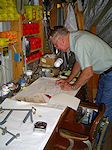
There are multiple sets of plans relating to specific components of this wooden plane. Tolerances are exact and work is "exacting." Here Steve Vasko checks and rechecks plans for a specific component.
|
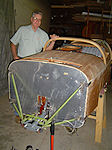
In 2008 Vasko carried the skeleton of this fuselage to his presentation of the GP-4 kit to the Zion men's group which meets at the Fellowship Hall of the church. Steve stands next to the fuselage now. The plane's engine will be mounted immediately in front of the fuselage as we see it.
|

Vasko fabricated aluminum fuel tanks which were mounted within the 24 foot wings. The wing partition holding the gas tank was then filled with a foam material that swelled to 30 times in volume once epoxy was added. Steve is pointing to the hardened foam in the wing which will ultimately be covered with the airplane's "skin," which he is constructing at this time.
|

Vasko has spent hours and hours in fabrication, gluing, welding, reviewing plans, getting details down to exact specifications. On April 12, 2011, the project continues.

Click each photo to enlarge.

The landing gear are also mounted in the wing, in this case, behind those aluminum gas tanks. The interior of the wing is shown in more detail here, each component hand crafted by Vasko and glued together, piece by piece. The special glue has to cure for a week at better than 70 degrees F for 24 hour days.
|

Vasko installed each landing gear which has an electrical, hydraulic, and mechanical component. The gear will be covered by a special cover which in turn will be covered by that airplane skin component.
|
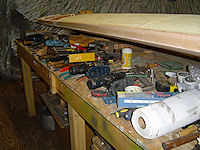
Here the wing is at the top of the picture. Different tools lie beneath the wing. Each tool has a special purpose for craftsman Vasko.
|

Here is an update in pictures revealing the slow progress on this complex job. Yes, it is slow at this point. Yet, when this plane is completed, the two-seater will fly at 240 miles per hour and get about 20 to 25 miles per gallon!
 
25 mpg and
It'll Do 240 mph!
Tuesday, May 13, 2008
 
Steve Vasko was a crop-duster in Baldwin for over 20 years. What do you do with a man with aviation fuel in his veins at retirement? His plane was gone as of 2000 when he sold it and the business and went into "retirement," at least from crop-dusting, because he and wife Becky are some of the busiest people we know in Silverhill!

Click each photo to enlarge.
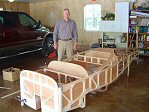
Steve is in the middle of construction of a GP-4 Experimental Plane. The fuselage, pictured here, has taken shape, front of the plane's engine compartment closest, and the wings are being assembled in Vasko's adjacent wood shop.
|
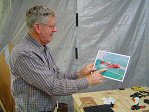
Steve points to his desired end-product, a GP-4 Experimental Plane. Craftsman Vasko is in the middle of fabrication of an all wooden "kit" plane from a 1984 design by George Pereira.
|

Fabrication began by constructing a table long enough for wings and fuselage to be assembled. Bench construction, leveling, materials, and other seemingly insignificant factors turn out to be significant.
|

Put things in perspective. Vasko always wanted to fly. He took lessons in Fairhope and qualified at various levels of proficiency to get into crop-dusting. He dusted crops for 22 years. His favorite plane was a turbo-prop Thrush. He had been thinking about building a plane from before he started working on those crops. So, retired, and with a little time on his hands, Vasko started looking for "something fast, something with retractable landing gear, and something of wood," a favorite material from his days in construction prior to crop-dusting. "Three years ago I found my kit. It's a GP-4 designed by George Pereira in 1984," Vasko noted. That means that the design has been used and tested by a variety of people in the last 25 years!

Click each photo to enlarge.

Steve received components of the GP-4 Experimental Plane which included aviation-quality wooden components. Steve points to a piece of "plywood" that runs about $250 a sheet!
|

Steve Vasko (standing) explained some of the details of
constructing an experimental airplane. His fuselage sits to the rear
of the picture. All pieces were custom-cut by Steven.
|

Some of the men got a close up view of the all-wood
fuselage. Components were epoxyed when assembled - no nails and no
screws.
|

Vasko sent for the kit and has been building lots of components this past winter. The plane is literally fabricated and built, piece by piece. His best estimate is that it will take 2000 to 3000 hours to complete. When he is done, the two-seater will fly at 240 miles per hour and get about 20 to 25 miles per gallon. Not bad!






|
|
|
|